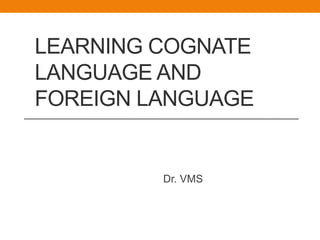
Cognate language learning and foreign language learning.pptx
- 1. LEARNING COGNATE LANGUAGE AND FOREIGN LANGUAGE Dr. VMS
- 2. Cognate languages • Cognate languages and words have the same origin, or are related and in some way similar • Cognates are often inherited from a shared parent language, but they may also involve borrowings from some other language.
- 3. Cognate • A cognate is a word that comes from the same origin as a word from a different language. Cognates between languages usually have similarities in spelling, pronunciation, and meaning. This means that someone who speaks English and knows the word ''doctor'' would be able to understand the meaning of the French word ''docteur'' even if they're completely unfamiliar with French.
- 4. Cognate • Cognates do not need to have the same meaning, which may have changed as the languages developed separately. For example English starve and Dutch sterven or German sterben ("to die") all derive from the same Proto-Germanic root, *sterbaną ("die")
- 5. Learning cognates • Cognates are the words that are easiest to learn because they’re similar to the words you already know, because they’re descended from the same root word. • for example, ‘important’ is cognate with: • French important • Spanish importante • Portuguese importante • Italian importante • Romanian important
- 6. Learning languages of the same family • Dravidian language family • Tamil-Kannada-Telugu-Malayalam, • Teaching-Pronunciation-word structure • Cultural similarity-dissimilarity- • Modified forms and meaning
- 7. Cognates of Dravidian languages umber Tamil Kannad a Malayal am Tulu Telugu Kolami Kurukh Brahui Proto- Dravidia n 1 onru ondu onnu onji okaṭi okkod oṇṭa asiṭ *oru(1) 2 iraṇṭu eraḍu raṇṭu raḍḍ renḍu irāṭ indiŋ irāṭ *iru(2) 3 mūnru mūru mūnnu mūji mūḍu mūndiŋ mūnd musiṭ *muC 4 nālu, nālku, nānku nālku nālu nāl nālugu nāliŋ nākh čār (II) *nān 5 ainthu aidu añcu ayN ayidu ayd 3 pancē (II) panč (II) *cayN 6 āru āru āru āji āru ār 3 soyyē (II) šaš (II) *caru 7 ēẓu ēlu ēẓu yēl ēḍu ēḍ 3 sattē (II) haft (II) *eẓu 8 eṭṭu eṇṭu eṭṭu edma enimidi enumad ī 3 aṭṭhē (II) hašt (II) *eṭṭu 9 onpathu ombattu onpatu ormba tommidi tomdī 3 naiṃyē (II) nōh (II) *toḷ 10 patthu hattu pattu patt padi padī 3 dassē dah (II) *pat(tu)
- 8. Foreign Language • What to teach? That means the amount of knowledge and skills that students have to obtain within the process of learning the language. • What are the aims of teaching? When a teacher is sure of the aim of teaching, he/she will have the easiness of reaching the stated goal. • How to teach? The principles upon which teaching of English is based, the means, methods, styles and tactics used in teaching in order to achieve the required objectives.
- 9. Challenges of Foreign Language Learning Languages known, Levels of proficiency, Subject contents, School organization, Participation of families and communities Availability of intercultural mediators/interpreters
- 10. L2 Learning Styles and Strategies • Memory • Cognitive • Comprehension • Metacognitive • Affective • Social
- 11. Memory • People who adopt the memory strategy depend on their memorizing ability. They find ways to remember better to aid in entering information into long-term memory, by creating a word-meaning map in their brain (mental linkages), and then being able to retrieve that information. Adopting this strategy will allow the learning and retrieval via sounds (e.g., rhyming), images (e.g., a mental picture of the word itself or the meaning of the word), a combination of sounds and images (e.g., the keyword method), body movement (e.g., total physical response), mechanical means (e.g., flashcards), or location (e.g., on a page or blackboard).
- 12. Cognitive strategy • People who adopt the cognitive strategy tend to analyse and reason. They form internal mental codes and revise them to receive and produce the message in the target language. Adopting this strategy will enable you to internalize the language in direct ways such as through reasoning, analysis, note-taking, summarizing, synthesizing, outlining, practicing in naturalistic settings, and practicing structures and sounds formally.
- 13. comprehension strategy • People who adopt the comprehension strategy find themselves guessing unknown words when listening and reading. They also try to replace words they do not know with longer phrases or other words that they know when speaking and writing to overcome gaps in knowledge.
- 14. Metacognitive strategy • People who adopt the metacognitive strategy plan, arrange, focus, evaluate on their own learning process. They identify and monitor their own learning style preferences and needs, such as gathering and organizing L2 materials, arranging a study space and a schedule for L2 revision and learning, monitoring mistakes made in L2, and evaluating task success, and evaluating the success of any type of learning strategy.
- 15. Social/Affective strategy • People who adopt the social/affective strategy control their feelings, motivations and attitudes when in social situations such as asking questions, communicating with others, facilitate conversation and interaction.